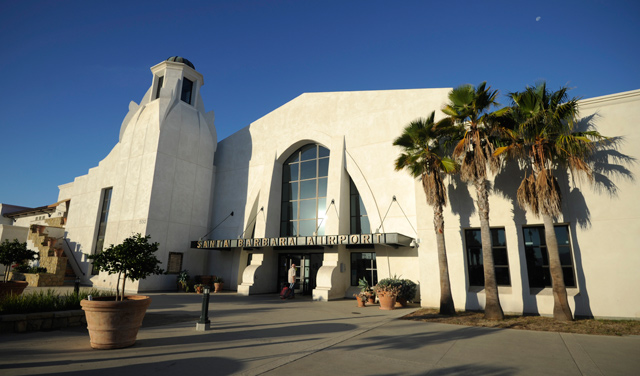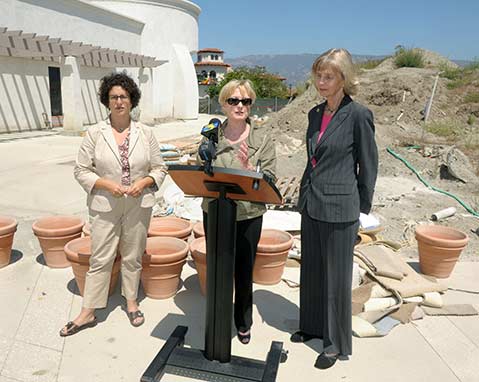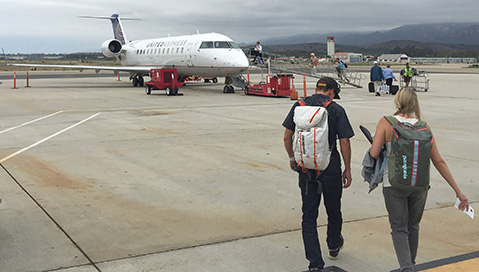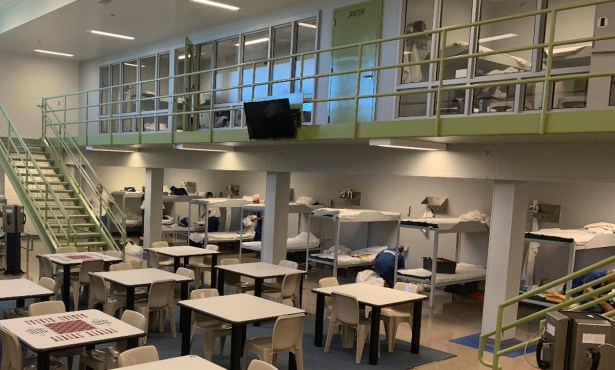Stiff Headwinds for Santa Barbara Airport
Passenger Counts Down Five Years After New Terminal Opens

Santa Barbara built it, but they did not come. Five years after the cavernous John T. Rickard airport terminal opened to much fanfare, the $37 million building sits strikingly empty. Sporadic footsteps echo through its high-ceilinged entryway, and bored employees lean behind a long row of empty ticket counters. One worker recently called it a “mausoleum.”
The 60,000-square-foot terminal was built to accommodate more than 1.3 million annual passengers, but it currently serves fewer than half that number. Since the new facility opened in August 2011, replacing the older, charming, if funky, terminal, the airport has reported $2.5 million in losses. In the nine years prior, it generated $6.3 million worth of income.
These nail-biting declines, say city officials, can be blamed on global forces outside their control. Since 2005, Santa Barbara Airport has lost 26 percent of flights and passengers, a similar fate faced by small-hub airports across the country. The terrorist attacks of 9/11, quadrupling fuel prices, two economic downturns, and stricter pilot-licensing standards forced all major carriers to either upend their business plans or go bankrupt. That’s meant overall fewer flights.
According to a Massachusetts Institute of Technology study on market factors shaping air travel, between 2007 and 2012, the 29 largest airports in the United States lost 8.8 percent of flights, while the smaller hubs lost 21.3 percent. Some airfields, like the ones in New Cuyama and Oxnard, watched all of their flights disappear. Santa Barbara is in no immediate danger of completely crashing — and, in many ways, is faring better than other cities — but major obstacles remain in steering passenger counts and finances back on course.
Airport officials say they have a plan. This Tuesday, City Hall hired a consultant who will study travel routes and analyze the “leakage” of area residents who fly out of Los Angeles. In recent months, airport director Hazel Johns and her team have also ramped up marketing and incentive programs, which have successfully reestablished direct flights to Dallas.
More importantly, Johns explained, she and Kathy Janega-Dykes with Visit Santa Barbara have started to bang the drum for community support. They’re asking hoteliers and business owners to pool funds and entice airlines with guaranteed returns on new flights out of Santa Barbara. It’s a strategy that’s worked for Palm Springs, Reno, and elsewhere, and Johns sees it as one piece in the complicated puzzle of maintaining and improving South Coast air service. “We can’t do it by ourselves,” she said.
Hard Times for Big Dreams
The John T. Rickard Terminal was designed based on a 2002 Aviation Facilities Plan that mapped the airport’s commercial activity through the year 2015. The plan relied on Federal Aviation Administration (FAA) and economic forecasts that passenger rates would rise an average of 3 percent a year, as they reliably had for the last century, even through world wars and the Great Depression. Those predictions, though, would prove woefully inaccurate, as Santa Barbara’s ridership peaked in 2005 and has been falling ever since. No one saw it coming, said Johns.
However, in the years leading up to the terminal’s groundbreaking in 2009, there were in fact grumblings among community activists who asserted Santa Barbara was investing in a white elephant. Dozens of public design meetings were held where these critics would complain the proposed terminal was much too big and too sterile. Like many Santa Barbarans, they maintained a deep fondness for the small yet functional 1942 terminal. Sure, the airport was a bit outmoded, they said, but was such a massive and expensive undertaking really necessary?

Capps (right) and Mayor Helene Schneider, talked about a construction
stop during the 2011 FAA shutdown.
Despite the consistent pushback, none of the detractors succeeded in making a sufficiently compelling argument against constructing a new terminal, remembered Mark Schniepp, at the time head of UCSB’s Economic Forecast Project. “We were following it closely,” he said, “and I don’t remember anyone armed with intelligent information that the airline industry was going to change.” Back then, Johns’s predecessor, Karen Ramsdell, oversaw the airport and its new construction. The City of Santa Barbara , which owns the airport and surrounding land, was led by Mayor Marty Blum with Jim Armstrong, an experienced pilot, serving as city administrator.
Johns defended the decision to build by pointing to the many shortcomings of the old terminal, such as its quirky outdoor baggage claim, awkward bathroom locations, and poor IT infrastructure. More critically, the 20,000-square-foot building was often filled beyond capacity, didn’t allow enough room for TSA equipment and personnel, and sat below a floodplain. “The terminal was built because we had to,” said Johns. “We literally had to.”
The new terminal and its related improvement projects, totaling $53 million, were funded through revenue bonds, federal grants, and passenger facility charges, explained Johns. No public money was used. Construction finished on time and under budget. Even if they knew then what they know now about declining passenger rates, Johns believes the city would have still moved forward with the project. “But perhaps it could be smaller,” she admitted.
In normal years, the airport was a self-sustaining operation with an annual budget of approximately $17 million. Revenues are generated mainly through airline, commercial property, and private aviation leases, which have either held steady or increased over the last 10 years. But so have expenditures, including a $1.8 million bump in salaries and benefits since 2005. And now with the annual obligation of $1.8 million in debt service for the next 30 years, the airport’s balance sheet has tipped into the red.
To make up for the losses and to keep operations running, the airport has eaten through much of what are called its unencumbered reserves, money that otherwise pays for building improvements and other capital expenses. For the last two years, Johns was also forced to postpone planned work and keep job vacancies open, particularly in the airport’s security patrol division. Two grant applications to the U.S. Department of Transportation were not successful. And last year, the City Council rejected a proposal to cut the number of firefighters on call from nine to six, which airport administrators estimated could have saved $600,000 a year. Citing concerns for public safety, councilmembers said other money-saving ideas should be explored first.
Councilmember Frank Hotchkiss, the City Council’s liaison to the Airport Commission, agreed there’s real cause for concern but that the commission, Johns, and her staff are working diligently to stop the bleeding. He said the lull in commercial aviation may present new opportunities to invest in private flight. “It’s a good crew out there,” Hotchkiss said. “They’re all over it. They’re not just sitting there, warming their feet.”
The Ups and Downs of Air Travel
Ticket prices out of Santa Barbara Airport have always been high. Occasionally they match fares at Burbank or LAX, but more often than not, they’re $100-$200 more. During the first financial quarter of 2016, Santa Barbara’s average ticket price was $519.52. The national average was $359.47; LAX’s was $361.85.
By and large, our airport and our checkbooks are at the mercy of the airlines. They set the prices and determine the routes. Those processes are secretive and complicated. “It’s worse than chess,” said Johns. Right now, three commercial airlines — Alaska, American, and United — offer 21 nonstop daily flights to Seattle, Portland, Dallas, Phoenix, Denver, Los Angeles, and San Francisco. And the airlines are filling their planes at those rates, so they have no reason to drop prices. Yet, if more than half of Santa Barbara’s residents drive or shuttle down to Los Angeles for the more affordable fares, as studies show, who is filling those planes? Wealthy tourists and rich residents, Johns said. So who does the airport truly serve?

To increase competition, which would drive down prices and make our airport a viable option for middle-income earners, Johns and her team are constantly trying to entice new carriers to come and to bring in more routes. In addition to American’s Dallas connection arriving in June, Alaska started a second daily flight to Seattle that same month. Passenger counts this September were up more than 10 percent from the year before, Johns was happy to report.
It’s a battle getting airlines to notice you, said Johns. “Keep in mind, there are 400-some-odd airports, and everyone is fighting for the same things,” she said. “It’s very competitive.” Like other directors, Johns regularly attends “speed-dating” events where cities deliver 20-minute pitches to airline executives. Some hand out T-shirts and gift bags — anything to stand out. It’s all about which cities can make the airlines the most money in the shortest amount of time. Usually, that means the largest hubs.
Ultra low-cost carriers such as JetBlue, Frontier Airlines, and Allegiant Air have been tough for Santa Barbara to catch and keep. They’re mostly concentrated on the East Coast and find it difficult to turn a profit with regional West Coast trips. Frontier and Allegiant both came and left in recent years. Now, Santa Barbara is actively courting Southwest, which recently upset the balance of power at the Long Beach Airport to the benefit of travelers. It’s also in discussions with a lost-cost Canadian carrier.
Airport Civilian Defense Team
In the meantime, the airport has partnered with Visit Santa Barbara to develop a minimum revenue guarantee program, wherein South Coast business and tourism leaders create a pot of cash that would be available to airlines if the revenues promised by a new route were not achieved. For airlines to even take notice, this cushion fund would need to hold $500,000–$1 million. “Air service recruitment is no longer just a “city” function or an “airport” function,” said Visit Santa Barbara’s Janega-Dykes, whose organization has launched a number of nationwide ad and branding campaigns in recent years. “It’s a community responsibility.”
Such a cushion fund paid for by nongovernmental organizations and private businesses has met with mixed reviews in the larger Santa Barbara community. (Under FAA rules, city and county governments can’t directly contribute money toward the program.) Kristen Miller, president of the Goleta Chamber of Commerce, thinks it’s a great idea. But she conceded she was initially irked by it. “Why should I have to pay for something that I used to just get?” she remembered asking herself, but then she emphasized, “The world has changed.” If Goleta needs to invest $500,000 to grow businesses, given how huge of an economic driver the airport is, “That seems very reasonable to [the Goleta Chamber],” said Miller.
Ken Oplinger, head of the Santa Barbara Chamber of Commerce, is more lukewarm on the idea, given the response he’s received from business leaders so far. “I’ll be honest; a lot of people are saying they’re not sure they want to invest in this,” he said. Most Santa Barbara companies simply don’t have the $25,000–$50,000 to spare. In other cities where the program has worked, larger corporations helped foot the bill. Still, Oplinger remains optimistic some kind of creative solution can be hatched. “We’re working on it,” he said.
Even if this particular strategy doesn’t pan out, the airport is scrambling on other fronts to find savings and generate more revenue, explained Councilmember Gregg Hart. It recently renegotiated its debt with the city, and sold an eight-acre piece of property to Direct Relief International for $8.7 million. Those funds are being reinvested in the construction of light industrial facilities on airport property. That market is hot right now, said Hart, since Santa Barbara’s gentrification has done away with many of those workspaces. Lastly, the old Tracor Aviation building on Fairview Avenue, currently leased by Wendy McCaw, will soon go back on the market. “That will be a big moneymaker,” said Hart.
Travelers can help, too, said Johns. When they can, they should fly out of Santa Barbara, as every ticket, parking spot, and burger purchased at the airport ultimately benefits the shared community asset. “Check us out first,” she said. “Give us a chance.”



